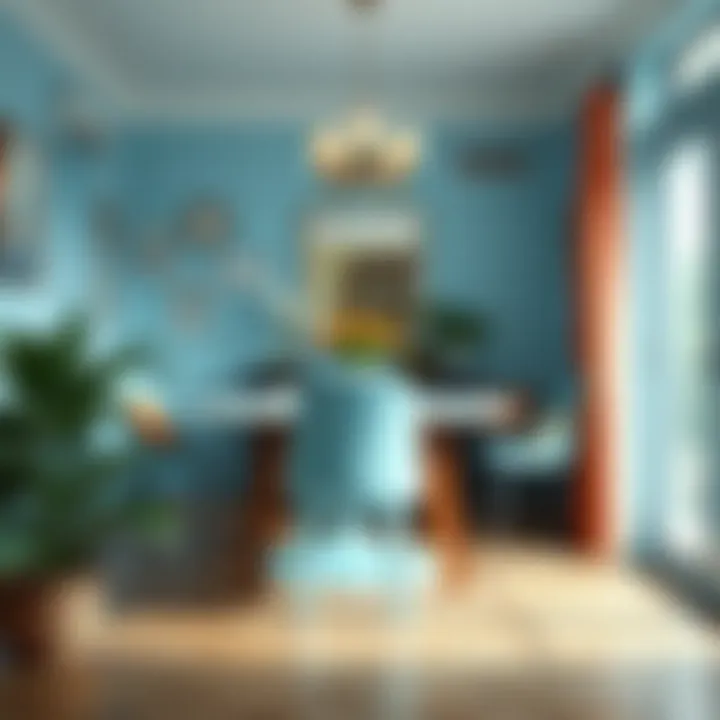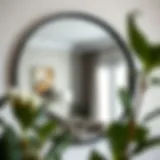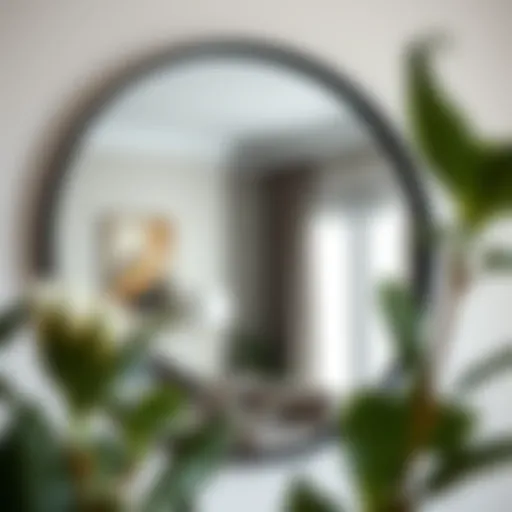The Pale Blue Chair: Exploring Design and Functionality


Intro
The pale blue chair often serves as more than just a piece of furniture; it embodies a thoughtful interplay of color, design, and functionality within the realm of interior design. Homeowners, interior designers, and DIY enthusiasts alike find themselves drawn to its soothing tones and versatility. This piece of furniture can act as a calming focal point in a living space, evoking feelings of tranquility while offering a practical seat.
In this exploration, we will dive into the charm of pale blue chairs and their impact on both aesthetics and usability. We'll uncover how color psychology plays a role in furniture selection, the prevailing trends in chair design, and practical considerations one should keep in mind when incorporating such pieces into different environments. Additionally, we will provide valuable maintenance tips, allowing these chairs to maintain their appeal over time.
Let's embark on this journey to understand not just the physical aspects of pale blue chairs but their deeper significance in design and functionality.
Furniture Design Trends
Current Styles and Aesthetics
In recent years, furniture design has increasingly leaned towards minimalist styles, often reflecting a preference for clean lines and uncluttered appearances. The pale blue chair finds its way into various aesthetics, from sleek modern designs to more rustic farmhouse chic vibes. In the modern realm, think chairs with simple structures, crafted from materials like molded plastic or sleek metal.
On the other hand, when we look at traditional styles, pale blue chairs might feature ornate carvings or soft upholstery, adding a touch of elegance while still providing a splash of color. For instance, imagine a classic wingback chair in a soft blue fabric—it's not just a seat; it's an invitation to unwind.
Color Palettes and Materials
The choices in color palettes for interiors continue to evolve, and pale blue effortlessly pairs with numerous other colors. It’s particularly striking when combined with warm wood tones or crisp whites, creating a balance that's both inviting and fresh. Fabrics can vary too—linen offers a relaxed look, while velvet brings a touch of luxury. Consider how texture modifies perception; a pale blue velvet chair can make a space feel glamorous and cozy simultaneously.
As palettes shift towards more earthy tones, having a standout pale blue chair might just become the highlight of a room. The right combination can elevate a traditionally muted space into something lively and cheerful. Think about pairing it with dusty pinks or muted greens for a contemporary twist.
Buying Guides
Essential Considerations When Purchasing
Choosing the right pale blue chair is not merely about aesthetics. Functionality, comfort, and durability ought to come into play. Here are a few factors to consider:
- Space Availability: Measure your area to ensure the chair fits aptly without crowding the room. A bulky chair might overwhelm a small nook.
- Comfort: Don’t skimp on comfort. Sit in the chair before committing; pay attention to support and cushion softness.
- Material: Depending on the chair’s use, select materials that can handle wear and tear while matching your lifestyle. For instance, if you have pets, you might want something with a tougher fabric.
Top Recommendations for Different Budgets
When it comes to investing in a pale blue chair, options abound across various price ranges. Here’s a brief list:
- Budget-Friendly Options: Check stores like IKEA or Wayfair for stylish yet affordable chairs that still carry that pale blue charm.
- Mid-Range Choices: West Elm and CB2 often feature chic mini-collections with a focus on versatility and modern design at reasonable prices.
- High-End Picks: For those with deeper pockets, brands like Ligne Roset and Knoll offer luxurious designs that not only serve as chairs but as timeless art pieces.
The goal is to find a balance between your budget and the quality of the piece. Investing in a pale blue chair can lead to a blossoming of style and functionality within your home.
"The right chair in the right space can transform both the chair and the space."
As you embark on the journey of selecting your pale blue chair, consider these aspects deeply. The perfect choice not only enhances your home’s aesthetic but also brings a touch of serenity that can improve your day-to-day experience.
The Significance of Color in Interior Design
Color plays a pivotal role in interior design, shaping not just the aesthetic appeal of a space, but also influencing emotions and behaviors. For the pale blue chair, color becomes more than a mere visual element; it transforms how we experience our surroundings. In this section, we will explore the deep-seated implications of color in design, touching on its psychological effects, foundational theories regarding color, and the unique charm of blue tones in home decor.
The Psychological Impact of Color
The hues in our environment can evoke a range of emotions, from warmth and comfort to calmness and creativity. Psychologists recognize that colors have a profound influence on mood. For example, blue is often associated with tranquility and serenity. When a homeowner chooses a pale blue chair, they might be seeking to create a peaceful oasis in their living room or a refreshing workspace.
Furthermore, studies suggest that certain colors can enhance productivity and promote relaxation. A well-placed pale blue chair in a home office might boost concentration, while a charming corner in the living room can invite relaxation after a long day.
"Color is the keyboard, the eyes are the harmonies, the soul is the piano with many strings." – Wassily Kandinsky
Color Theory Basics
Understanding color theory is essential for making informed design choices. At its core, color theory encompasses how colors interact and influence one another. Primary colors—red, blue, and yellow—serve as the foundation for secondary colors, while complementary colors, which sit opposite each other on the color wheel, enhance one another when used together.
For instance, a pale blue chair beautifully contrasts with warm tones like oranges or yellows. This creates visual interest and balances the room's color palette. On another note, analogous colors, like teal or soft green, paired with a pale blue chair can create a harmonious and soothing environment, which can be particularly appealing in spaces meant for relaxation.
The Allure of Blue in Home Decor
Blue has held a special place in the world of design for centuries. Its associations with nature—sky and ocean—invoke feelings of freedom and peace. This allure extends into the realm of interior design, where pale blue, in particular, can inject a sense of calm elegance into any space.
The versatility of pale blue is remarkable. It can fit comfortably within various design styles—be it modern, traditional, or even coastal. It also complements a wide range of textures and materials. A pale blue chair, for example, would look stunning paired with rustic wooden tables or sleek glass surfaces, allowing it to adapt as designs and trends evolve.
By choosing a pale blue chair, homeowners not only enhance the visual appeal of their space, but they also curate an atmosphere that reflects their personal style while fostering a welcoming environment.
Historical Perspectives on Chair Design
Understanding the historical context of chair design is crucial for anyone looking to appreciate the craftsmanship and creativity that goes into a simple piece of furniture like a chair. Over the centuries, chairs have transitioned through various styles, materials, and cultural significance, reflecting the values and preferences of different eras. This section delves into how these styles have evolved, showcasing the rich tapestry of design innovation that has shaped what we perceive as seating today.
Evolution of Chair Styles
Chairs have been around for centuries, serving not just as functional pieces of furniture, but also as symbols of status and comfort. The journey of chair design begins back in ancient Egypt, where wooden chairs with intricate carvings were a sign of high social status. From then on, styles evolved dramatically:
- The Gothic style, prominent in the Middle Ages, featured heavy, ornate designs often crafted from oak. Chairs had high backs and were used in ecclesiastical settings.
- In the Renaissance, chairs became more refined and were often upholstered. The inclusion of rich fabrics showcased wealth, and the designs reflected classical influences, leading to more elegant silhouettes.
- Fast forward to the 18th century, the emergence of the Chippendale style introduced graceful curves with a mix of influences from Chinese and Gothic design.
- The Industrial Revolution later brought about mass production, resulting in simpler designs that were more accessible to the everyday person, a shift from the craftsmanship of earlier periods.
This evolution continued, presaging the modern designs we see today, which often blend comfort with various forms of artistic expression. Each style tells a story, a reflection of not just the functional needs but also the aesthetic ideals of its time.
Influential Designers and Movements
Throughout history, certain designers and movements have reshaped the chair design landscape. These figures didn’t just create chairs; they influenced how society interacts with furniture. Consider these major contributors:


- Bauhaus Movement: In the early 20th century, the Bauhaus movement focused on simplicity and functionality. Designers like Marcel Breuer developed chairs using materials such as tubular steel, emphasizing that form should follow function. This was revolutionary, marking a shift away from ornate designs.
- Charles and Ray Eames: Known for their innovative use of materials, the Eameses crafted chairs that were not only comfortable but stylish. Their lounge chair and ottoman made of molded plywood and leather are still sought after today, symbolizing mid-century modern design.
- Hans Wegner: A pivotal figure in Danish design, Wegner believed that chairs should not only be seen but also experienced. His work, particularly with the Wishbone Chair, emphasizes both beauty and ergonomics, making his furniture timeless.
Each of these designers introduced ideas that challenged the status quo, pushing the boundaries of how chairs could look and function.
Pale Blue in Historical Context
Color plays a pivotal role in chair design, affecting mood and perception. The frequency of certain colors, including pale blue, has shifted throughout history. In past centuries, blue was often associated with royalty and tranquility due to the rarity of blue pigments. As we analyze its historical context:
- Colonial America: Pale blue hues were common in homes as they evoked a sense of calmness and serenity in interiors. The use of these shades indicated a refined taste and a connection to nature.
- 20th Century Design: The soft blue shades became emblematic in the mid-20th-century modern design movement. Icons of this era often utilized pale blue for its calming qualities, believing in its ability to create serene living spaces.
- Current Trends: Today, pale blue finds its place in various design styles, blending seamlessly with everything from minimalist designs to bohemian aesthetics. Its versatility allows it to complement a wide range of colors and materials, making it a preferred choice for many designers and homeowners alike.
By examining the history of chair design and the contextual significance of colors such as pale blue, we gain insight into not just aesthetics, but also the sociocultural narratives that influence consumer choices. This knowledge allows both designers and homeowners to make informed decisions when selecting furniture for their spaces.
Choosing the Right Pale Blue Chair
Selecting a pale blue chair might seem a straightforward task, yet understanding its role within your living space is crucial. The right choice can transform an ordinary room into an extraordinary retreat, offering both visual appeal and practical functionality. This section dives into the key considerations when opting for a pale blue chair, ensuring that your decision aligns with your aesthetic preferences and lifestyle needs.
Considerations for Space and Functionality
When contemplating a pale blue chair, assessing the space it will inhabit is a must. Consider the dimension of the room. A sprawling space can host a larger statement piece, whereas a cozy corner may benefit from a compact, petite chair. Visual weight matters—light colors tend to appear less bulky, allowing them to blend seamlessly into various environments. This makes a pale blue chair ideal for enhancing openness in smaller areas.
Accessibility and Functionality: Think about how the chair will be used. Will it serve as a reading nook, a dining seat, or a casual spot for conversation? Each purpose demands different considerations. A chair with an inviting structure and comfortable cushioning works wonders in living rooms and reading spaces. On the other hand, for dining areas, consider a design that is both stylish and durable.
Another factor is the arrangement of your furniture. Placing your pale blue chair in relation to other elements such as couches or tables can affect the overall flow of the room. Ensure that there's enough space to maneuver between furniture pieces without feeling cramped.
Materials and Their Impact on Style
The material of your pale blue chair greatly influences both its comfort and aesthetic impression. Whether you opt for plush fabric, sleek velvet, or natural wood, each choice imparts a different vibe. Fabric varieties like linen or cotton lend a casual, relaxed air, making them perfect for a family room or a guest area, while leather or faux leather evokes sophistication and durability, suitable for a more formal setting.
Durability and Care: Evaluate how each material withstands daily use. For households with children or pets, stain-resistant and easy-to-clean fabrics should be on your list. Additionally, fabrics that hold their color well can keep your pale blue chair looking fresh over time. A classic cotton blend might be more susceptible to fading, while a fabric treated with special coatings maintains vibrancy across seasons.
Finding the Perfect Shade of Blue
Not all blues are created equal, especially when it comes to choosing the right hue for your chair. Pale blue can evoke a range of feelings and impressions, from soothing tranquility to vibrant playfulness, depending on its undertone.
When picking a shade, it’s worth testing swatches under various lighting conditions. Natural light will showcase the color differently than overhead or nighttime lighting can. This varied perspective is essential to select a hue that resonates with your overall design.
Matching and Complementing Colors: Pale blue chairs can harmonize beautifully with a multitude of color palettes—think creams, sandy neutrals, or even pops of brighter colors like yellows or coral. Consider how the chair’s hue interacts with existing decor. You want your chair to complement the space, not clash with it.
"The nuances of color in a space can greatly influence mood and atmosphere. Choosing wisely leads to a home that resonates harmony."
In summary, choosing the right pale blue chair involves much more than just aesthetics. From understanding space demands to selecting appropriate materials and shades, each element plays a vital role in ensuring that your choice not only beautifies your home but also enriches your everyday life. The right chair can become a cherished spot in your space, marrying form and function elegantly.
The Versatility of the Pale Blue Chair
The pale blue chair is far more than a mere piece of furniture; it serves as a canvas upon which the stories of design and personality converge. This section explores its versatility, shedding light on its adaptability within different decor styles, its role in color coordination, and the interplay of various materials and textures that enhance its appeal. While a chair might often be an afterthought in interior design, the pale blue chair stands out as a thoughtful choice that says much about one’s style and preferences.
Complementing Various Aesthetic Themes
The pale blue chair integrates seamlessly into a variety of aesthetic themes, boosting both visual interest and comfort in a space. For instance, in a modern minimalist setting, a pale blue chair can act as a soft focal point against stark lines and neutral colors. This gentle hue evokes calmness, providing a counterbalance to the rigidity often found in minimalist designs.
On the flip side, in bohemian settings where color and texture reign supreme, a pale blue chair enhances the eclectic atmosphere. Here, it can harmonize with bold patterns and layered textiles, adding tranquility amid chaos. This adaptability makes the pale blue chair a chameleon of sorts, shifting to complement its surroundings rather than overpower them.
"A pale blue chair not only fits into a space; it transforms it."
Balancing Colors in a Room
When placing a pale blue chair in a room, there's a fine art to balancing colors that needs consideration. The softness of pale blue naturally pairs with warm tones like soft yellows or creamy whites, creating a soothing palette. However, it also plays nicely with deeper colors such as navy or emerald green, offering a striking contrast without clashing. By understanding color theory—particularly complementary and analogous colors—homeowners can craft a space that feels cohesive.
Strategies for achieving a balanced color scheme may include:
- Layering: Using pale blue as a base color, then introducing other hues as accents.
- Contrasting Elements: Pairing the chair with darker furniture items or accessories to draw the eye.
- Textural Balance: Introducing varied textures like a plush throw or smooth finish to provide tactile interest.
Mixed Materials and Textures
The tactile allure of a pale blue chair lies in its ability to interplay with various materials and textures. For instance, a velvet pale blue chair exudes luxury and comfort while inviting the touch, making it perfect for a cozy reading nook. Contrarily, a pale blue chair made from wood with a distressed finish can evoke a rustic vibe, pairing beautifully with more organic elements like jute or linen.
It’s worth noting that combining different textures can enhance the overall aesthetic. Consider incorporating:
- Textured Fabrics: Combining the chair with a chunky knit throw or a soft faux fur can create a layered, inviting look.
- Natural Elements: Wood, stone, or plants near or around the chair can complement its cool tones, adding a hint of earthy richness.
- Metal Accents: A pale blue chair can look striking beside metallic elements, bringing warmth to the space without excessive shine.
By embracing diversity in materials and textures surrounding the pale blue chair, owners can craft a space that feels both dynamic and thoughtfully curated.
Functional Aspects of a Pale Blue Chair
When considering the pale blue chair, it’s essential to delve into its functional aspects. Beyond aesthetics, these elements contribute significantly to the chair's usability and appeal in a variety of settings. Many homeowners, designers, and DIY enthusiasts regard these factors as necessary, ensuring that a chair isn’t just visually pleasing but serves its intended purpose effectively.
Ergonomics and Comfort
The ergonomics of a pale blue chair holds remarkable importance, especially for those who spend extended hours in it. A chair designed with comfort in mind promotes better posture and reduces strain on the body. For instance, the seat height, depth, and backrest angle are crucial for providing support that aligns with the user’s body.
Moreover, the cushioning material is also a vital consideration. Premium foam or memory foam can enhance comfort levels significantly, making the chair suitable for various activities—from reading to working on a laptop. "The right chair can make you feel at ease and help you focus, while a poorly designed one can lead to discomfort."
Durability of Materials


The durability of materials used in furniture, particularly in a pale blue chair, determines its lifespan and resilience. Opting for robust upholstery like canvas, leather, or high-performance fabrics can ensure that the chair withstands daily wear and tear. Other factors like the frame material also play a substantial role; solid wood or metal frames often provide a sturdy base that can support a fair amount of weight without wobbling.
Additionally, considering the style in which the chair is used can influence its durability. For instance, if placed in a high-traffic area like a living room or dining space, selecting spill-resistant and stain-resistant fabrics is prudent. This approach maintains the chair's appearance and longevity, helping to keep its color vibrant.
Adaptability Across Settings
One of the standout features of a pale blue chair is its adaptability. It can seamlessly integrate into diverse settings, such as a cozy living room, an elegant dining area, or a contemporary home office. Its color, while unique, can complement various palettes and styles, from minimalist to bohemian designs.
- Living Room: A pale blue chair can serve as a chic accent piece that draws attention without overwhelming the space.
- Dining Areas: It can introduce a refreshing splash of color, making meals inviting and vibrant.
- Home Offices: The calming hue can create a more conducive workspace, potentially boosting productivity.
In every setting, the pale blue chair can be enhanced with the proper accessories—think patterned throw pillows or a contrasting ottoman. This adaptability allows homeowners to make a statement while retaining functionality in their furniture choices.
Epilogue
In sum, evaluating the functional aspects of a pale blue chair is crucial for ensuring it not only beautifies a space but also serves its practical purpose effectively. Prioritizing ergonomics, durability, and adaptability will help in selecting the right chair to suit individual needs and enhance the overall living experience.
Caring for Your Pale Blue Chair
Maintaining the beauty and functionality of a pale blue chair requires some attention to care and upkeep. This section is important as it ensures that the chair not only retains its aesthetic appeal but also serves its purpose effectively over time. Correctly caring for fabric and styling can elevate a space while minimizing the need for replacements or significant repairs.
Cleaning Guidelines for Fabric Chairs
To keep a pale blue chair looking fresh, cleaning is essential. Fabric chairs attract dust, stains, and allergens, which can dull their appearance. Here are some guidelines for proper cleaning:
- Regular Vacuuming: Use a soft brush attachment on your vacuum cleaner to remove dust from the chair surface and crevices. Aim to do this weekly to prevent buildup.
- Spot Cleaning: For immediate response to spills, dab (do not rub) the affected area with a clean, dry cloth. Mix a mild detergent with water, dampen a cloth, and gently blot to lift any stubborn stains, then rinse with plain water to avoid soap residue.
- Deep Cleaning: Every 6-12 months, consider a deeper clean. Depending on the fabric, this may involve steam cleaning or professional upholstery cleaning services. Always test in an inconspicuous area first to check for colorfastness.
Addressing Wear and Tear
Like any furniture, a pale blue chair can face wear and tear, especially in high-traffic areas. Here’s how to effectively address it:
- Routine Inspections: Regularly check for loose seams, fabric fraying, or cushioning issues. Catching these problems early can make repairs easier and cheaper.
- Repair Loose Seams: A needle and thread can go a long way. For minor frays or loose threads, sewing can prevent larger issues. If you’re unsure, take it to a professional tailor.
- Cushion Restructuring: Over time, cushions may flatten. Replacing filling or adding extra cushioning can bring the chair back to life. Memory foam is an excellent option for comfort renewal.
Maintaining Color Vibrancy
The irresistible charm of a pale blue chair is often its primary draw; however, the color can fade over time due to sunlight and general wear. Here are ways to keep that color vibrant:
- Avoid Direct Sunlight: Position your chair away from windows or use curtains to diffuse sunlight. UV rays can significantly fade fabric colors.
- Use Color-Safe Cleaners: Select cleaning products that are safe for colored fabrics. Products with bleach or harsh chemicals can strip the color and ruin the fabric.
- Rotate and Rearrange: If your space allows, rotate the chair’s position occasionally. This minimizes uneven fading and helps the color last longer.
In Summary: Cared-for pale blue chairs can be lasting features in any home decor. Regular cleaning, repairing, and maintenance of color are keys to keeping that charming hue intact and your chair looking its best. Remember, investment in your furniture’s upkeep is an investment in your home’s style and comfort.
For more in-depth information on furniture care, you might consider visiting Wikipedia Furniture or Britannica Furniture Maintenance.
Sustainable Choices in Chair Design
As the world increasingly embraces environmentally-conscious living, the conversation around sustainability in furniture design becomes more central. When homeowners and designers select a pale blue chair, they are not just considering aesthetics or comfort; they are also making choices that can significantly impact health, the environment, and social welfare. This section assesses the importance of sustainable decisions in chair design, highlighting unique materials, ethical practices, and long-term durability.
Eco-Friendly Materials
Using eco-friendly materials in chair production is key to reducing our carbon footprint. Makers who pivot to sustainable materials often use resources like bamboo, recycled plastics, or certified woods. Bamboo, for example, is a popular contender; it grows rapidly and absorbs carbon more efficiently than traditional hardwoods, making it an environmentally sound choice.
Furthermore, recycled materials help in combating waste. Designers who utilize fabrics made from post-consumer plastics are not just reducing dependency on new materials; they are crafting a narrative of upcycling and resourcefulness. For many, the choice of a pale blue chair crafted from such materials signifies a step toward greener living spaces.
"Every chair tells a story, not just of purpose but of the materials that breathe life into its form."
Ethical Manufacturing Processes
Equally important is where and how the chairs are made. Ethical manufacturing embraces fair labor practices, ensuring workers are compensated justly and work in safe conditions. When choosing a pale blue chair, it helps to dive into the brand's manufacturing ethos. Brands engaged in ethical practices often share how they verify their supply chains and the types of labor they employ.
For instance, many artisans focus on local production to curtail shipping emissions while also supporting local economies. This method of production often enhances the craftsmanship of each piece, giving homeowners a unique chair imbued with local culture and care.
Long-Term Sustainability in Furniture
Sustainability doesn't end at production; it permeates the entire lifecycle of a chair. Long-lasting materials and designs that remain chic over years, rather than succumbing to trends, enhance long-term sustainability. Investing in a pale blue chair crafted with quality materials means it can become a family heirloom, reducing the need for frequent replacements.
Considerations for durability not only speak to the chair's life span but also to its impact on the environment. Fewer replacements mean less waste in landfills and a more responsible consumption model overall. For homeowners keen on sustainability, assessing the longevity of a chair before purchase can lead to more meaningful decisions that reflect a commitment to both style and the planet.
Ultimately, the dialogue surrounding sustainable choices in chair design is an invitation to homeowners, designers, and DIY enthusiasts to make intentional selections. By marrying aesthetics with responsibility, this mindful approach nurtures not only individual spaces but also broader eco-systems.
Incorporating Pale Blue Chairs in Diverse Spaces
Incorporating pale blue chairs into various spaces of the home is more than just a design choice; it’s about creating an ambiance that resonates with comfort and style. The pale blue hue, often associated with tranquility and serenity, can effortlessly transform a room. Whether it's the living room, dining area, or home office, the addition of a pale blue chair introduces not only aesthetic appeal but also enhances functionality.
One of the key benefits of using pale blue chairs is their versatility. It pairs well with a variety of color schemes, allowing homeowners to create a cohesive look that feels curated yet easygoing. The soft tone of pale blue can highlight other colors in a space, allowing for a balanced and welcoming environment. Consider the following elements when incorporating a pale blue chair in your home:
- Complementary Color Pairings: Pale blue works beautifully with whites, grays, and muted pastels. It also finds a surprising harmony with bolder colors like mustard yellow or deep navy. This compatibility lets decorators play with contrasts while keeping a soothing aura.
- Functional Aesthetics: Choosing pale blue chairs for different settings isn’t just about looks. Their design affects the functionality of the space, offering comfort during long sitting periods.
- Individual Expression: Integrating this hue allows owners to express their personality. A pale blue chair can act as a statement piece, reflecting a serene, confident style.
As we explore specific spaces for pale blue chairs, it becomes evident how these elements blend to create inviting, well-rounded environments.
Living Rooms: Creating a Relaxing Space
Living rooms are typically the heart of the home where gatherings happen, and relaxation is a priority. A pale blue chair can significantly contribute to a calming atmosphere. When placed strategically near a window or in a corner nook, it invites natural light, enhancing its serene color.
- Design Tips: Position the chair close to other seating options, creating a cozy area for social gatherings. Think of ways to complement it with throw pillows in various textures that echo shades of blue or adjacent colors.
- Lighting: Consider using soft lighting that enhances the pale blue’s essence. A well-placed floor lamp or table lamp with a warm bulb creates a warm ambiance.


Dining Areas: A Splash of Color
Dining areas can benefit from the freshness of a pale blue chair. It serves as an ideal way to introduce color without overwhelming the space.
- Table Pairing: Match the chair with a wooden or white table to maintain elegance. Using pale blue alongside natural materials brings an inviting warmth that encourages long meals and conversation.
- Table Settings: For a harmonious look, choose table settings that echo the chair’s hue, perhaps through dishware or centerpieces that incorporate shades of blue.
Home Offices: Enhancing Productivity
In a home office, the color palette can significantly impact productivity and creativity. A pale blue chair might provide just the inspiration needed for focused work sessions.
- Positive Psychology: Soft colors like pale blue can lower anxiety levels and increase concentration. Setting up an office chair in this color amidst plants or artwork can create an environment that enthuses.
- Flexible Usage: With a focus on both function and fashion, a pale blue chair can be easily moved around the space as needed, making it not just a seat but a dynamic part of your workspace strategy.
Ultimately, incorporating pale blue chairs in various spaces adds both style and substance, enhancing everyday living with thoughtful, color-rich choices.
Comparative Analysis: Pale Blue vs. Other Colors
Understanding the interplay between pale blue and other colors in interior design is crucial. It's like standing at a crossroads where choices of color significantly shape the identity of a space. The allure of pale blue lies not just in its visual appeal, but also in its psychological impact and how it contrasts with other color families.
In this section, we’ll break down why it matters to know how pale blue stacks up against its counterparts, and discuss the emotional and aesthetic dimensions this color brings to a room.
Warm Tones vs. Cool Tones
Warm tones like red, orange, and yellow radiate a sense of energy and vibrancy. They can evoke feelings of warmth and intimacy, making spaces feel more inviting. However, when comparing warm tones with cool tones like pale blue, the latter often brings a tranquil vibe into the mix, offering a respite from the hectic pace of life.
- Warm tones can feel overbearing in small spaces, while pale blue often makes a room appear larger and more open.
- Pale blue, as a cool tone, can induce feelings of serenity and relaxation, making it ideal for rooms dedicated to rest, such as bedrooms or studies.
- Mixing pale blue with warm colors can create a dynamic tension. For example, pairing a pale blue chair with golden yellow cushions might bring balance to an area while keeping the energy levels in check.
In essence, knowing how pale blue interacts with warm tones allows homeowners and designers to create harmonious interiors that cater to various moods and settings.
Neutral Colors: Balancing the Interior
Neutral colors like beige, gray, or white serve as a backdrop in a well-designed space, allowing for other elements to shine. When pale blue chairs enter the scene, they become focal points without clashing with understated neutrals.
Consider these aspects:
- Soft Contrast: A pale blue chair juxtaposed with a beige wall can enhance the calming effect of the room—a subtle yet effective approach to color balance.
- Layering Textures: Neutrals provide a perfect foundation, allowing the texture of a pale blue chair to come to life. For instance, a linen chair in pale blue can dramatically enhance the warmth of a wooden floor without overpowering the space.
- Fleeting Visual Interest: Items in neutral tones can draw attention to more vivid accents. A pale blue chair topped with colorful cushions can shift the focus dynamically throughout the day as light changes within the room.
Understanding how neutral colors complement pale blue helps create interiors that feel balanced yet visually engaging.
Highlighting Personality with Color Choices
The choice of a pale blue chair can say a lot about an individual's taste and personality. Color reflects emotion and style, and integrating pale blue into a design isn’t just about aesthetics; it’s about storytelling.
- Personal Expression: For homeowners, a pale blue chair might connect with memories of sunny skies or ocean waves, lending a personal touch to the home.
- Creating a Unique Character: Adding unique patterns or accessories to a pale blue chair can reflect specific interests or styles, allowing for an outward expression of personal creativity. Think of graphic pillows or a colorful throw that offers depth and intrigue.
- Vibrant Highlights: Striking a balance between pale blue and bolder colors can showcase one's daring side. A pale blue chair can stand proudly next to a bright red or lush green, creating an energetic space reflective of a lively personality.
Ultimately, making deliberate color choices allows homeowners to curate their environment in a manner that resonates with personal values and aesthetics, making every space feel uniquely theirs.
"Color is the keyboard, the eyes are the harmonies, the soul is the piano with many strings." - Wassily Kandinsky
The Future of Chair Design
Looking ahead in chair design, it’s imperative to examine how changes in society, technology, and aesthetics converge. The future of these essential furniture pieces involves exploring innovative materials, responding to consumer tastes, and enhancing comfort and functionality. As we embrace sustainability, creating a chair that is not only visually appealing but environmentally conscious is becoming increasingly important. The pale blue chair embodies this intersection of style and purpose, reflecting consumer values and advancing the design narrative into uncharted territory.
Emerging Trends in Color and Material
In terms of color, the soft yet striking allure of pale blue continues to gain traction. Designers are blending this hue with a variety of materials that express both modern flair and timeless sophistication. For example, pairing pale blue with natural wood or metal accents reveals a harmonious balance, appealing to both minimalist and maximalist palates. Additionally, trends such as biophilic design, which emphasizes a connection to nature, have encouraged the use of eco-friendly materials. Bamboo and reclaimed wood are on the rise, allowing homeowners to curate spaces that resonate with the essence of natural landscapes.
The material choices are also interwoven with functionality. Upholstery fabrics are evolving too, with technological innovations enabling the creation of performance textiles that resist stains while enhancing comfort. As such, there’s a growing emphasis on chairs that embody versatility, adapting to various lifestyles without compromising on aesthetic quality.
Technology in Furniture Design
The integration of technology into furniture design is a game-changer. Smart chairs equipped with features like adjustable ergonomics or built-in charging ports are making waves in modern interiors. These enhancements are transforming the pale blue chair from a mere seating solution into a multifunctional piece that caters to the demands of contemporary living. The trend toward automation is not just about convenience; it also opens up opportunities for better personalization and improved user experience.
Moreover, augmented reality (AR) applications allow consumers to visualize how a pale blue chair fits within their home environment before making an investment. This shift toward technology-driven designs showcases a clear alignment between consumer preferences and manufacturing capabilities, marking a significant step forward in the way we approach furniture buying decisions.
Consumer Preferences and Market Shifts
As we delve deeper into consumer preferences, it becomes evident that there’s a notable shift toward sustainable and ethical purchasing decisions. More homeowners, designers, and DIY enthusiasts are advocating for furniture that reflects their values. The pale blue chair stands as a testament to this movement. By leaning into sustainable practices, manufacturers who utilize eco-friendly materials and ethical production processes cater to a discerning clientele seeking to create a home that embodies both comfort and conscience.
In addition, the rise of social media platforms offers a unique marketplace for design inspiration. Consumers are more aware of trending aesthetics, manifesting in increased demand for unique colors and styles. The influence of platforms like Pinterest and Instagram shapes how individuals visualize their spaces, leading to an explosion of creativity as customers seek to incorporate elements like the pale blue chair into their designs.
"The future of chair design is not just about the piece itself; it’s about the experience it creates and the values it represents."
In summary, the future of chair design, particularly the pale blue chair, positions itself at the crossroads of innovation, sustainability, and consumer-driven trends. As the landscape of interior design continues to evolve, keeping an eye on these transformative aspects will empower homeowners and designers alike to create spaces that resonate with individual identity and collective consciousness.
Finale: The Enduring Appeal of the Pale Blue Chair
The pale blue chair carries with it a distinctive charm that goes beyond mere aesthetics. Its significance in interior design is paved by a mix of psychological impact, versatility, and ability to unify various themes within a space. This all boils down to a few key elements that hold weight in our understanding of why a simple chair can play such a crucial role in the decor of any room.
Reflecting on Style and Function
When considering style, the pale blue chair serves as a perfect canvas. It holds the unique ability to fit into diverse styles, whether embracing a vintage look or a more contemporary vibe. This is not just about being visually appealing; it’s also about functionality. The chair operates seamlessly in any setting, from chic urban lofts to cozy suburban homes. The combination of color and design allows the pale blue chair to stand out while simultaneously blending in with its environment. A thoughtful choice can lead to a cohesive look that reflects one's personal taste.
Inviting Individual Expression through Design
A pale blue chair isn't simply a piece of furniture; it’s a statement. By bringing such a piece into a space, homeowners find an opportunity to express their individuality. The color blue, often associated with calmness and tranquility, can set the tone for a room or even an entire home. Whether you choose a sleek pale blue chair or one that boasts intricate patterns, these designs inspire an environment that is uniquely yours. With the right accents—a quirky pillow or an art piece on the wall—it invites whimsy and personal touch.
Pale Blue Chairs: A Timeless Addition to Any Space
Finally, the pale blue chair stands the test of time, making it a wise investment. Its hue never goes out of style, and paired with various colors, it continues to evolve with trends, providing long-lasting appeal. Unlike trendy colors that fade from grace, pale blue has a way of remaining relevant, making it suitable for both contemporary and classic collections. As life's stages change, so does our use of furniture, but a pale blue chair can adapt effortlessly to fit these transitions, assuring its place in your home for years to come.
"The beauty of a pale blue chair lies not just in its color but in the layers of meaning it adds to a space."















